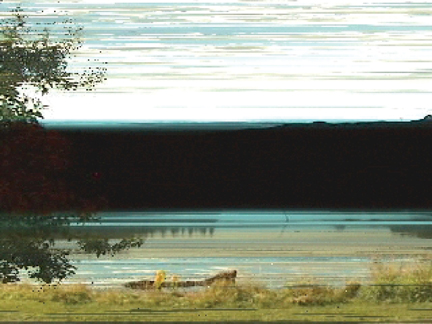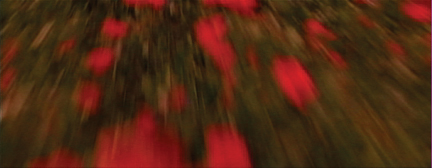[Fall 2008]
Oakville Galleries, Oakville
June 29 – August 26, 2007
In a world in which “Outlook” is perhaps recognized more immediately as the name of a software program than as a word meaning “approach to life”, it seems fitting that this pair of exhibitions takes as its starting point the premise of using technology as a frame through which to look upon the world in two ways: in its landscape form, in Outlook Express(ed), and in its information and informatics forms, in Accumulated Outlook.
These two exhibitions elucidated one another, although their physical separation by the geography of Oakville – one exhibition at the downtown Centennial Square site, the other at the Gairloch Gardens location – marked a shift of focus from the interior and synthetic processing of the “real” through the digital to the ostensibly more passive consideration of the natural world as captured by stationary devices of reception. While distinct in their formulation and conception, and each sufficiently well formed to stand alone, these exhibitions, through their coincidence, illuminated the multiple modes of data processing by their constituent artists, who used both active and passive forms of collection in their reformulation of found and situated material.
Accumulated Outlook, curated by Peter Ride, included the work of Dara Gellman and Leslie Peters, Cheryl Sourkes, and Thomson & Craighead, all of whom process material that has been naturalized through technological engagements into forms that offer viewers insight into both the familiarity and the alien qualities of the processed universe. Gellman and Peters’s work, Impossible Landscapes, was a video installation in which they processed uninhabited landscape images from television and film into a wholly new and continuously flowing landscape that moved viewers through the work as though they were players in an immersive first-person video game. The sense of movement through the video, which was accompanied by a wordless soundtrack that highlighted the changes in tension and pacing of the imagery, was palpable, and the spaces traversed, though impossible to know, seemed vaguely familiar.
This culling of imagery from familiar sources and its processing into uncommon or unexpected form was also undertaken by Cheryl Sourkes in her Homecammer series, in which she grabbed and enlarged still images from personal webcams to the point at which the astonishingly banal acts captured become almost subservient to the painterly effects of the images’ dissolution. This aestheticization of content that has become commonplace is also the project of Thomson & Craighead, whose Decorative Newsfeeds do just as the title suggests: in travelling curlicues and arcs, fragments from Internet newsfeeds scroll in white text across a dark screen, their visual elegance often at odds with the terse phrasing and dire messages of the news items themselves. These artists process the informational transmissions of the televisual and online environments into accumulations of both meaning (real and perceived) and viewpoint. The content of the news and the exhibitionism of those in front of the webcams appear uninflected by the artists who present them; they are shown with remarkable neutrality, and they speak to the capacity for emergence of the poetic in spaces where the manufactured and the real (or apparently real) collide.
This neutrality was present also in the works in Outlook Express(ed), curated by Marnie Fleming for the Gairloch Gardens site. In this exhibition, David Rokeby, Susan Collins, and Lois Andison presented work that addressed the processing of the pastoral through digital means over extended periods of time. The work was particularly resonant in this gallery, situated in a garden overlooking Lake Ontario. Here, the artists’ reflection on the natural world seemed to be less about nostalgia for connection to land and place than about an opportunity to investigate the ways in which viewers could be invited to participate in the meditation on meaning and change of the subject sites of nature that were presented by the artists.
Susan Collins’s Glenlandia presented a landscape image accumulating through a fascinatingly and achingly paced agglomeration of pixels: at the rate of one pixel per second, an image of a natural-looking but synthetic landscape formation, Loch Faskally in Scotland, is transmitted to the gallery via live webcam. In near-real time from many time zones to the east, an image is built, tracking changes in natural, ambient light such that any full image of the loch is as much in the dark as it is in the light. The image is constantly and slowly overwritten by its own replacement – the same site, the same view, with slightly differing light and weather conditions. In this way, the image, while whole, is always fragmentary, an accumulation of time-affected factors. The pixels accrue as we would read: from left to right, and in rows from top to bottom, forming an impossible likeness, one that exceeds what could be seen were we to stand in the location of the camera itself.
David Rokeby’s work provides a particular contextual engagement with the site of exhibition in that Gairloch Gardens itself is the subject of his work. In Machine for Making Time, Rokeby recorded swaths of the gardens using a camera mounted on the gallery building, and then randomized the playback of those stills such that the continuous visual arc across the landscape is retained, but the narrative flow of content is disrupted across seasons, weather conditions, and time. Conversely, Lois Andison’s time and again retains narrative in space and time as it replays one calendar year’s photographing, at half-hour intervals, of the view from a single window through which we see the anticipated changes of the seasons, and the unanticipated progress of a local building project within the frame of the camera. The opportunity here to contemplate particular views, to have outlooks framed, casts light on the matter of speed in relation to “normal” change; slowed, sped, and discontinuous, these narratives highlight the degree to which human intervention is so constitutive of “natural” change.
In both of these exhibitions, the matter of decision-making is very much at the fore. In equal measure, these artists take close care of their means of selection and also cede much decision-making to either randomized or pre-selected mechanisms that may at one point render the artist’s agentive presence almost moot. In the accumulation and expression of outlooks within these exhibitions, the pastoral and the processed are not so much in conflict as they are in cahoots to offer both reflections and refractions of the natural and synthetic worlds that we inhabit contemporaneously.
Jessica Wyman is a writer, art historian, and award-winning curator who teaches at the Ontario College of Art and Design.


